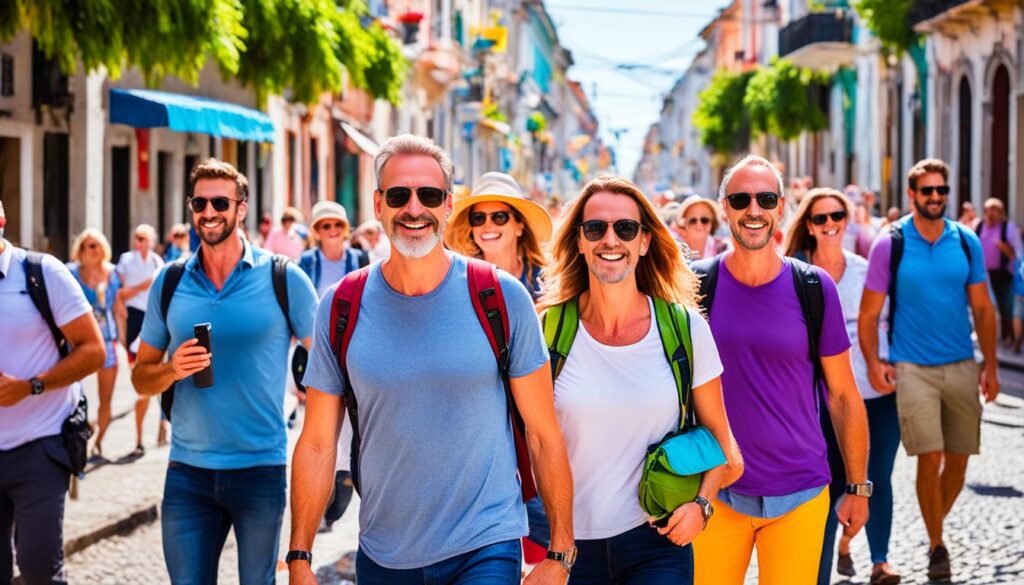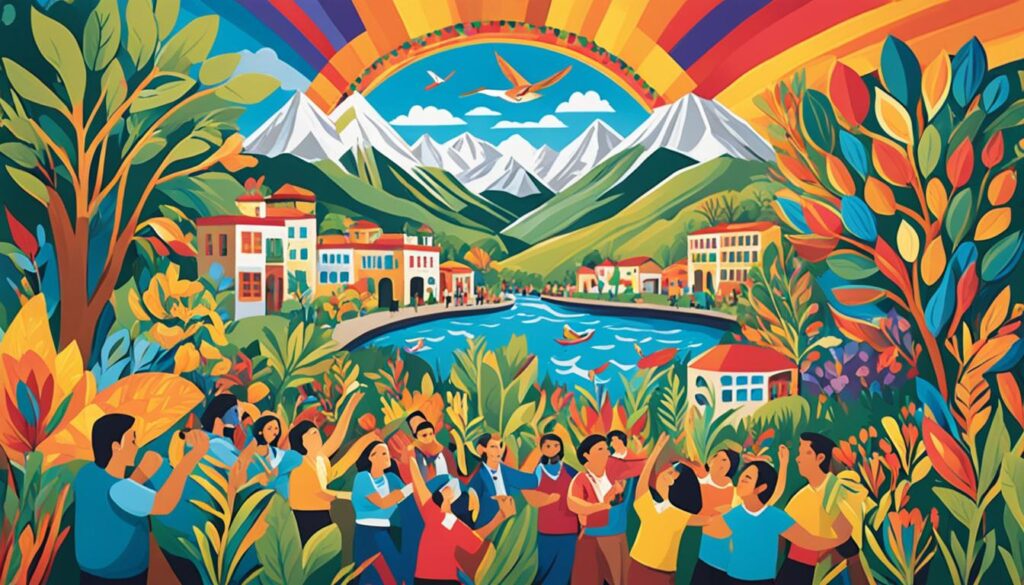Last Updated on: 24th January 2025, 03:07 pm
As we embark on a new year, the topic of travel safety in Latin America becomes paramount for globetrotters keen on exploring vibrant cultures and stunning landscapes. The 2025 safest destinations in Latin America are attracting increasing attention, particularly countries like Uruguay, El Salvador, Costa Rica, Paraguay, and Argentina. These nations are not only known for their breathtaking scenery but also for their significant strides in ensuring secure environments for both locals and tourists alike.
Safety dynamics can vary significantly across the continent, making it crucial to understand the nuances of each destination. For instance, while Paraguay is ranked 77th on the Global Peace Index (GPI) with a GPI of 1.94, making it a safer travel option1, countries like Ecuador, with its GPI of 2.101, and the Galapagos Islands—virtually crime-free—are also appealing secure travel destinations2. Meanwhile, Brazil and Colombia present more safety challenges, ranking 130th and 144th out of 163 countries on the Global Peace Index, respectively1. Understanding these ratings helps travelers make informed choices about where to explore next.
Key Takeaways
- Uruguay continues to hold the top spot as the safest country in Latin America2.
- Paraguay and Argentina are among the top picks for secure travel destinations in Latin America13.
- Ecuador, though facing some safety issues, has regions like the Galapagos Islands with nearly zero crime rates2.
- Understanding the Global Peace Index rankings can aid in selecting the safest Latin American destinations for 20251.
- Chile’s low violence rates make it an attractive destination for safety-conscious travelers2.
Contact us if you are Interested in Buying Property Abroad!
Introduction to the Safest Latin American Countries
Latin America encompasses a vast geographical area, stretching from Mexico in North America through Central America and the Caribbean, down to the southernmost tip of South America. This region includes a diverse range of countries that speak Spanish, Portuguese, and French, each with its unique cultural and social landscapes. Understanding Latin American regions is crucial for travelers aiming to explore the safest countries in Latin America.
For those assessing a Latin America safety overview, it is vital to recognize that violent crime is often concentrated in larger cities and primarily affects local residents rather than visitors. Various countries in Latin America are frequently highlighted for their relative safety and low crime rates. Among them, Uruguay stands out, ranking 52nd globally and 2nd in the region with a Global Peace Index (GPI) score of 1.893, largely due to its political stability and minimal violent crime rates4.
Similarly, Argentina has risen to prominence as one of the safest countries in Latin America. In 2025, it ranked 47th globally with a GPI score of 1.8555. Argentina’s improvement in the GPI from 1.837 in 2023 to 1.911 in 2022 also indicates continuous progress towards safety6.
Moreover, Costa Rica consistently features among low crime rate countries in Latin America, earning the 58th spot worldwide with a GPI score of 1.9504. Known for its lush landscapes and eco-tourism, Costa Rica provides a secure environment for tourists seeking a peaceful vacation.
While assessing the Latin America safety overview, it is notable that El Salvador, once infamous for dangerous street gangs, has made remarkable strides in safety, now positioned as the 10th safest country in the region5. This transformation is a testament to how targeted efforts can dramatically improve a nation’s security dynamics.
Geographical diversity and cultural richness mark Latin America’s allure for visitors. Understanding Latin American regions is imperative when considering travel plans, ensuring visits to the safest, most welcoming locales. By focusing on countries with lower crime rates and higher GPI rankings, travelers can enjoy their adventures with peace of mind.
Why Safety Matters During Travel

Traveling safely in Latin America is a priority for many tourists due to the region’s diverse political and social landscapes. The Global Peace Index and travel advisories play a significant role in shaping travel plans and creating awareness of security issues.
Understanding Global Peace Index
The Global Peace Index (GPI) evaluates the safety of a country by incorporating 23 different metrics, offering a comprehensive safety score. For 2025, Latin American countries have seen fluctuations in their rankings. For instance, Ecuador is considered a pretty safe country for travelers, although certain areas near the Ecuador-Colombia border remain risky due to drug production and trafficking7.
In using the Global Peace Index and travel data, it’s crucial to understand the nuances of each country’s specific safety considerations. Millions of solo female travelers visit South America annually, emphasizing the need for reliable and current safety information8.
Common Safety Issues in Latin America
Common challenges for safe travel to Latin America include varying crime rates and political instability. Reports have indicated incidents such as robberies facilitated by fake taxi drivers in South America7. Likewise, travel-related accidents, including fatalities during activities like Death Road biking in Bolivia, highlight the risks travelers might face8.
Robberies and muggings are prevalent crimes, but with careful planning, these risks can be minimized. Learning basic Spanish or Portuguese can significantly improve communication with locals, leading to safer traveling experiences7. This is particularly beneficial for keeping abreast of local safety advice.
Moreover, opting for ‘radio taxis’ in countries like Bolivia and choosing safe bus companies based on local recommendations can also enhance personal security7. Researching others’ experiences remains an essential step towards ensuring safe travel practices, especially for long bus journeys in South America8.
Another critical aspect is staying vigilant against overly familiar locals, as this comfort can sometimes lead to risky situations8. For comprehensive information on safety best practices, visit Global Guardian.
Safest Latin American Countries

When considering secure Latin American destinations for 2025, several countries stand out for their dedication to safety, political stability, and low crime rates. Here, we delve into the safest nations in South America, specifically focusing on Uruguay, El Salvador, Costa Rica, Paraguay, and Argentina.
Uruguay
Uruguay is renowned for its low crime rates and political stability. Ranked as the second safest nation in Latin America according to the Global Peace Index9, Uruguay continues to maintain its secure environment with effective law enforcement and robust societal measures. The European-like cultural atmosphere further enhances its appeal to travelers.
El Salvador
El Salvador has witnessed remarkable safety improvements in recent years. This transformation is attributed to formidable government measures aimed at crime reduction, converting the nation from one of the more dangerous regions to a considerably secure destination. The ongoing enhancement of security structures ensures a safer travel experience.
Costa Rica
Cost Rica boasts an overall safety score of 1.73/5, rendering it the safest country in Latin America10. Holding the third position among the safest countries in Latin America based on the Global Peace Index9, Costa Rica is praised for its low crime rates. The nation’s focus on maintaining secure environments for tourists solidifies its place as a top destination.
Paraguay
Known for its low violent crime rate, Paraguay’s safety is largely due to effective law enforcement policies9. The country has achieved a level 1 rating by the U.S. government’s travel advisories, with increased caution advised only near the northeastern border with Brazil11. Its continuous efforts to maintain peace and safety make it a secure Latin American destination.
Argentina
Achieving the rank of the safest country in Latin America for 2025 according to the Global Peace Index9, Argentina sets itself apart with notable safety and security measures. Despite an increased risk of crime in specific areas such as Rosario, the country remains relatively safe for travelers overall11. Argentina’s dedication to improving safety highlights its commitment to being a top pick for safe travel in Latin America.
Travel Tips for Safe Adventures in Latin America

When planning your trip to Latin America, it’s crucial to understand essential travel safety tips and safety best practices while traveling. Avoiding high-risk areas can significantly enhance your journey, making it both enjoyable and secure. Here we discuss effective travel strategies to avoid risk areas and general safety practices you can adopt.
Avoiding Risk Areas
One of the key elements of risk avoidance in Latin America is to familiarize yourself with regions that have higher safety concerns. For instance, Venezuela is currently deemed a no-go zone for travelers due to widespread safety issues12. In contrast, countries like Uruguay, Argentina, and Chile are relatively safer, with Uruguay ranking as the safest in South America according to the Global Peace Index 202313. Travelers should also be cautious in urban environments—pickpocketing, muggings, and car break-ins are common in cities like Buenos Aires and Santiago13.
General Safety Practices
To ensure you have a safe adventure, here are some safety best practices while traveling:
- Use Official Transportation: Always opt for registered taxi providers and official transportation services to avoid incidents, as unlicensed taxi drivers are a growing issue in Santiago13.
- Stay Informed: Keep up-to-date with local news to be aware of any emerging safety threats. The US State Department advises increased caution when visiting Santiago due to assaults and muggings13.
- Minimize Wealth Displays: Public displays of wealth can attract unwanted attention. Keep valuable items discreet and secure.
- Engage with Locals: Connecting with residents can provide insights into safe areas and inform you about regional safety nuances.
Additional travel safety tips include staying vigilant of distraction thefts, particularly in busy areas like Buenos Aires13, and budgeting wisely, as most travelers in South America spend between $30-50 per day12. Researching more about the safest countries and strategies for protection can be done by visiting this comprehensive guide12.
Contact us if you are Interested in Buying Property Abroad!
Why Certain Countries Are Excluded from the List

When compiling a list of the safest Latin American destinations for 2025, several safety considerations for Latin American travel play a vital role. For instance, Chile is often excluded due to pockets of political unrest that have persisted for years. In some areas, frequent protests and clashes with law enforcement create a volatile environment, making it challenging to guarantee traveler safety.
Another essential factor in discerning safe Latin American countries is the complex security landscape of Panama. While Panama City is relatively safe for tourists, regions like Colon and the notorious Darien Gap present significant risks. The Darien Gap, notorious for its dangerous smuggling routes, has been linked with criminal activities and armed conflicts, posing severe dangers to travelers14.
Safety considerations for Latin American travel also extend to extreme measures taken in response to crime waves. For instance, El Salvador has recorded over 73,000 arbitrary detentions since March 2022, primarily targeting those accused of gang-related illegal associations14. Such stringent security measures may create an atmosphere of unpredictability for visitors.
Nicaragua’s critical human rights stance is another factor explaining why exclude certain Latin American countries. Over 3,394 NGOs have been closed since 2018, significantly limiting civil society’s role and creating an oppressive atmosphere14. Meanwhile, Venezuela faces its own set of challenges, including around 15,700 arbitrary arrests between 2014 and 2023, complicating the safety landscape for potential tourists14.
Another dimension in discerning safe Latin American countries involves the treatment and safety of human rights defenders. Brazil, for example, has witnessed an average of three human rights defenders being murdered each month over the past four years, indicating a dire environment for those advocating for justice and equality14. Honduras holds the tragic record for the highest number of human rights defenders killed per capita globally, reflecting severe risks that make it unsuited for inclusion in the safest lists14.
Furthermore, the phenomenon of climate change also contributes to why exclude certain Latin American countries from the safest destinations. Countries like Brazil and the USA are significant contributors to global greenhouse gas emissions, which exacerbates environmental challenges in the region14. Such ecological concerns can indirectly affect travelers’ safety and well-being.
In summary, understanding why certain countries are excluded from the list requires a multi-faceted approach. From political unrest and severe human rights issues to gang violence and environmental concerns, various factors collectively render specific countries less safe for travelers. It’s crucial to navigate these complexities when considering the safest Latin American countries for travel.
The Role of Local Culture in Safety

Local culture plays a pivotal role in ensuring the safety of both residents and travelers in Latin America. Uruguay, for instance, is renowned for its high political stability and low rates of violent crime, making it a prime example of how cultural practices can enhance a nation’s safety profile. Understanding the cultural influence on travel safety gives tourists the confidence to explore the region.
Political Stability and Safety
Political stability is a crucial factor in safety, as evidenced by the situation in Uruguay. This country has successfully maintained a stable political environment, which significantly reduces the instances of violent crime15. Moreover, political stability as a safety factor is emphasized when we consider that approximately 10% of Latin Americans reported paying bribes in 2009, highlighting the challenges that political and institutional corruption pose to safety in other countries16.
Cultural Practices That Promote Safety
Cultural safety practices in Latin America, such as prohibiting exposed tattoos and specific forms of clothing and maintaining group cohesion during off-site activities, play a significant role in promoting a safer environment for everyone15. For instance, proper behavior in work projects emphasizes safety as a top priority, focusing on self-motivation and adherence to local procedures15. Additionally, guidelines that restrict romantic relationships and discourage overt flirtatious behavior contribute to a respectful and secure atmosphere15.
Through ingrained cultural practices, such as communal focus on safety and local collaboration, many Latin American countries have fostered environments where safety is prioritized. This communal effort is crucial, especially in scenarios where political corruption might otherwise hamper safety initiatives16. These integrated safety measures are a testament to the significant cultural influence on travel safety in the region, providing a more secure experience for visitors.
Furthermore, research shows that Latin America has made substantial strides in enhancing the culture of safety within hospitals, particularly through national patient safety programs and specialized interventions in surgical centers and obstetric units17. These efforts underscore the importance of cultural practices in ensuring safety across various sectors, making countries in Latin America highly recommended destinations for safe travel experiences.
Understanding Travel Advisories

Travel advisories play a crucial role in helping travelers assess the safety of their destinations. These advisories, often issued by entities like the U.S. State Department, provide essential information on current safety conditions in various countries. Understanding the travel advisory significance is vital for making informed travel decisions.
The U.S. State Department advisories and travel guidelines categorize risks into four distinct levels. Level 1 advises travelers to exercise normal precautions. An analysis shows that 65.7% of Latin American countries fall into this category18. Level 2 suggests exercising increased caution, covering about 20% of the region18. Level 3 advises reconsidering travel, noted in 10% of cases, while Level 4 explicitly warns against traveling, applicable to 4.3% of the countries18.
The State Department advisories also highlight specific threats such as violent crimes, including in Mexico, where issues like homicide, kidnapping, carjacking, and robbery are rampant19. Some regions, such as Colima, Guerrero, Michoacan, Sinaloa, Tamaulipas, and Zacatecas, have more severe advisories due to crime and kidnapping, urging travelers to steer clear19. Baja California, Chihuahua, and other states require reconsidering travel due to similar risks19.
Comparing these advisories with the Global Peace Index (GPI) offers travelers a more comprehensive perspective on safety. GPI provides an international gauge of peace, while State Department advisories give up-to-date, localized insights. For instance, Latin American countries have seen varying advisory update dates, with the most recent on August 6, 2025, and the earliest on October 19, 202318.
While assessing travel risks via advisories, it’s crucial to note that certain Latin American areas such as Campeche and Yucatan are considered safer, with no specific travel restrictions for governmental employees19. This distinction aids travelers in choosing safer routes and regions, ensuring more secure travels.
For a detailed comparison of advisories in Central America, consult sources like this helpful guide for further insights.
| Travel Advisory Level | Percentage of Latin American Countries | Example Countries |
|---|---|---|
| Level 1 (Exercise Normal Precautions) | 65.7% | Uruguay |
| Level 2 (Exercise Increased Caution) | 20% | Costa Rica |
| Level 3 (Reconsider Travel) | 10% | El Salvador |
| Level 4 (Do Not Travel) | 4.3% | Venezuela |
Personal Experiences of 2025 Travelers

The year 2025 has brought a myriad of travel stories from Latin America, demonstrating the safety and enriching experiences that await adventurers. From the bustling streets of Buenos Aires to the serene landscapes of Montevideo, traveler anecdotes highlight how safe and enjoyable these destinations can be.
Real Stories from Safe Travels
One traveler recounted their delightful journey through Argentina, the safest country in Latin America for 2025, ranked 47th globally with a Global Peace Index of 1.8555. The local culture entwined with European elegance offered both security and charm. Similarly, Uruguay, with its welcoming atmosphere and the 52nd global ranking, created a haven for tourists seeking a peaceful getaway5.
In Costa Rica, standing as the third safest country with a Global Peace Index of 1.9505, eco-tourists shared their stories about the country’s lush biodiversity and its politically stable environment. The tranquil vibes of Monteverde and La Fortuna provided not just stunning views but also a safety net for curious adventurers9. Such traveler anecdotes are not only common but also reassuring for those planning their trips.
Lessons Learned
Travelers have gleaned several lessons from safe Latin American travel. Firstly, adherence to local advice and cultural norms significantly enhances safety measures. For instance, following recommendations from locals in Bolivia, the fifth safest country in Latin America, ensured a worry-free exploration of its vibrant culture and breathtaking landscapes5.
Another vital lesson is the importance of staying updated with current travel advisories. Many tourists who visited Ecuador praised the government’s efforts to improve infrastructure and reduce corruption, which heightened their sense of security and enjoyment9. Likewise, Panama’s persistent dedication to fostering a secure environment has earned it the reputation of being one of the safest choices for travelers9.
Ultimately, these firsthand experiences and 2025 travel stories from various travelers underscore critical insights that not only affirm the safety of these Latin American destinations but also illustrate the joy and fulfillment of exploring them. Practical safety measures and cultural sensitivity are cornerstones that have made these journeys memorable and secure.
Conclusion
Summarizing the insightful journey through the safest Latin American destinations in 2025, it’s clear that travel safety remains paramount. From countries like Uruguay and Costa Rica to Argentina, travelers can explore beautiful landscapes with peace of mind, bolstered by Global Peace Index rankings and vigilant travel advisories20. Embracing safe travel behaviors enhances these experiences, ensuring a memorable yet secure adventure.
Understanding travel advisories goes hand-in-hand with recognizing local cultures and political stability. Countries like El Salvador and Paraguay have shown remarkable improvements in safety, thanks to both community efforts and national policies20. These aspects are critical in our safe Latin American destinations recap, as they highlight the interconnectedness of cultural norms, safety practices, and governmental measures.
In conclusion, the journey through Latin America’s safest destinations in 2025 isn’t just about selecting countries based on safety rankings. It’s equally important to adopt a travel safety summary by considering health infrastructures, new health challenges brought by urbanization, and the dynamic cultural landscapes21. By understanding these factors and approaching travel with both confidence and precaution, you can fully enjoy the beautiful and secure places Latin America has to offer.
Contact us if you are Interested in Buying Property Abroad!
FAQ
What are the safest countries in Latin America for 2025
Why is Uruguay considered safe for travelers?
How did El Salvador improve its safety status?
What are some safety tips for traveling in Latin America?
What is the Global Peace Index, and why is it important?
Why are Venezuela, Ecuador, and regions within Brazil considered less safe?
How does local culture affect a country's safety?
Why were Chile and Panama excluded from the list of safest countries?
How do travel advisories help assess safety?
What are some common safety challenges travelers face in Latin America?
Can you share some positive traveler experiences in the safest Latin American countries?
Source Links
- https://www.theblogler.com/safest-countries-in-south-america/
- https://blog.volunteerworld.com/the-7-safest-places-to-visit-in-latin-america/
- https://travelnoire.com/safest-countries-in-south-america
- https://adventuretoeverycountry.com/safest-latin-american-countries-to-visit/
- https://visitworld.today/blog/1921/the-safest-countries-in-latin-america-a-detailed-overview
- https://worldpopulationreview.com/country-rankings/safest-countries-in-south-america
- https://budgettraveller.org/is-it-safe-to-travel-in-south-america/
- https://worldlyadventurer.com/safe-travel-in-south-america/
- https://nomadcapitalist.com/expat/safest-countries-in-latin-america/
- https://capturetheatlas.com/safest-latin-american-countries/
- https://www.frommers.com/tips/health-and-travel-insurance/what-are-the-safest-countries-to-visit-in-south-america-right-now
- https://www.desktodirtbag.com/south-america/
- https://worldlyadventurer.com/is-it-safe-to-travel-south-america/
- https://www.amnesty.org/en/location/americas/report-americas/
- https://www.notredamecollege.edu/sites/default/files/LatinAmericanCulturalSafetyIssues.pdf
- https://www.culturaldiplomacy.org/academy/index.php?en_cdea_european-latin-american-relationship
- https://www.ncbi.nlm.nih.gov/pmc/articles/PMC10565275/
- https://travel.state.gov/content/travel/en/traveladvisories/traveladvisories.html/
- https://travel.state.gov/content/travel/en/traveladvisories/traveladvisories/mexico-travel-advisory.html
- https://journals.openedition.org/poldev/2377
- https://www.ncbi.nlm.nih.gov/books/NBK236446/
Best Countries According to Aparthotel.com
- Best Countries To Live In Europe
- Best Countries To Move To From Canada
- Best Country To Live In
- Top Birth Tourism Countries
- Cheapest Asian Country To Live In
- Cleanest Country In The World
- Countries With No Capital Gains Tax
- Countries That Allow Dual Citizenship
- Countries With No Income Tax
- Countries With No Inheritance Tax
- Countries With No Property Tax
- Easiest Countries To Move To From USA
- Easiest EU Country To Get Citizenship
- Hardest Countries To Immigrate To
- Highest Tax Paying Country
- Instant Citizenship Countries
- Least Corrupt African Countries
- Lowest Tax Countries
- Non Extradition Countries
- Safest Countries In Africa
- Safest Countries In Europe
- Safest Country In Asia
- Safest Country In The World
- Safest Latin American Countries
- Second Passport Countries
- Territorial Tax Countries
- Which Country Pays Highest Salary

As a passionate, global-thinking Real Estate Investor I am constantly looking for the best opportunities to invest in Properties. With Aparthotel.com I am building an All-In-One Global Real Estate Platform, where people can analyse, rent or invest in properties. Additionally I help Investors with comparing the best financing options as well as give detailed Consultation on the buying process for Real Estate Investments around the world. I am looking forward to sharing my knowledge on this Website and feel free to reach out to me if you have any questions.

Comments